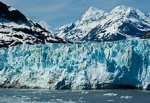- Joined
- Dec 31, 2016
- Messages
- 11,375
- Reaction score
- 2,650
- Gender
- Male
- Political Leaning
- Independent
In the National Park Service website, it talks about Glacier Bay and Alaska.
https://www.nps.gov/glba/learn/nature/climate-change.htm
Warming is more pronounced at higher latitudes. Over the past 50 years Alaska's annual average temperature has increased at more than twice the rate of the rest of the United States' average, and here in Southeast Alaska winters are 5 degrees warmer. Glacier Bay is expected to become warmer and drier over the next century. Widespread effects in Alaska include earlier spring snowmelt, reduced sea ice, shrinking glaciers, melting permafrost, bark beetle infestations, shoreline erosion, and more forest fires.
I just returned from a cruise of Glacier Bay. It was absolutely incredible, but at the same time it was sad. You can literally watch as the ice slides off the glacier, and into the bay.

https://www.nps.gov/glba/learn/nature/climate-change.htm
Warming is more pronounced at higher latitudes. Over the past 50 years Alaska's annual average temperature has increased at more than twice the rate of the rest of the United States' average, and here in Southeast Alaska winters are 5 degrees warmer. Glacier Bay is expected to become warmer and drier over the next century. Widespread effects in Alaska include earlier spring snowmelt, reduced sea ice, shrinking glaciers, melting permafrost, bark beetle infestations, shoreline erosion, and more forest fires.
I just returned from a cruise of Glacier Bay. It was absolutely incredible, but at the same time it was sad. You can literally watch as the ice slides off the glacier, and into the bay.

